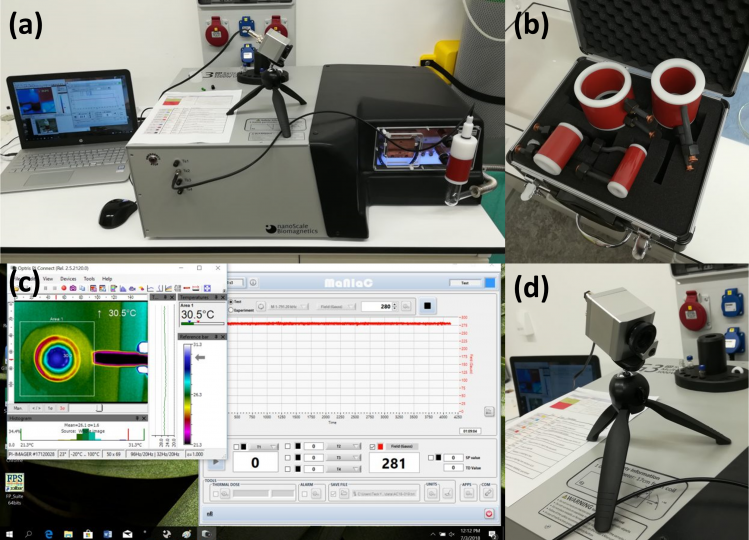High-frequency magnetic field calorimetry & chemistry
We explore the influence of external alternating magnetic fields on heating abilities of magnetic nanoparticles and their hybrids. Calorimetric studies are performed using the D5 system from NanoBiomagnetics (http://www.nbnanoscale.com/). The D5 system (Figure 1), which consists of Driver device G3, set of coils and thermal image system, allows to perform experiments at different frequencies and field values (up to 16 frequency modes for each coil). The Driver is controlled by Maniac, the software from NanoBiomagnetics. The Driver is equipped with one integrated fiber optic probe for high precision temperature measurement.
The system is equipped with a set of large-bore coils for MF-assisted chemical synthesis.

Figure 1. (a) G3 Driver with coil set CAL 2, thermal fiber optic probe and thermal camera. (b) Set of solenoid type coils. (c) Snapshot of thermal imaging system IR1 and Maniac software interface during a chemical reaction of magnetic nanoparticles solution components which took place under field of 280 G and frequency 791 kHz. (d) Thermal System Accessory IR1 with Driver.
High-frequency magnetic field Raman spectroscopy
We also developed a unique technique capable of detecting the hyperthermia-induced processes (heating, catalysis, thermo-responsive chemistry, etc.) on the level of chemical bonds and excitonic processes (Figure 2). A custom flat coil system coupled to the D5 system is placed in the Raman microscope (Witec alpha300R). The Raman (and also photoluminescence) spectra are monitored using a long working distance objective in situ during application of the high-frequency magnetic field. The sample is placed in a spectroscopic-grade cuvette with isolation to minimize the heat losses.

Figure 2. Scheme of the high-frequency Raman setup capable of in situ monitoring of the hyperthermic processes.

